Objects of the Week

This section of the website records the eclectic series of items that the programme produced.
The program ran from July 2020 to September 2021 with a total of 59 items being submitted.
A selection of the objects were displayed at Horticultural Society Show in September 2021. See the image on the right.
For reasons of privacy, names of individual submitters have been omitted.
3rd July 2020 Object 1
A Victorian Seal
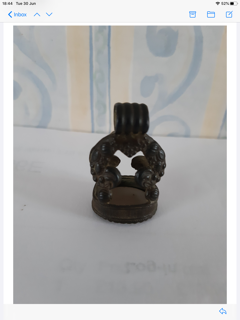 |
 |
 |
 |
The object was found by EM in the fields behind Brickwick and Coleshill House, about 10 years ago.
AYLESBURY MUSEUM's opinion is that it is a VICTORIAN SEAL with the owner’s portrait etched out in glass.
10th July 2020 Object 2
A Fossilised Sea Urchin
 |
 |
 |
The object, submitted by LT, is a fossilised Sea Urchin found in a nearby field.
It is approx 50mm in diameter, and probably over 55 million years old, but just like the multi-coloured urchins common among the kelp on rocky seabeds round the UK.
Note the five light coloured decorative lines where prickles would have projected, and the round vent on the underside. It is the same family as the five armed starfish.
Keep an eye open for these when roaming our local fields after ploughing.
17th July 2020 Object 3
A Porcelain Dental Flask
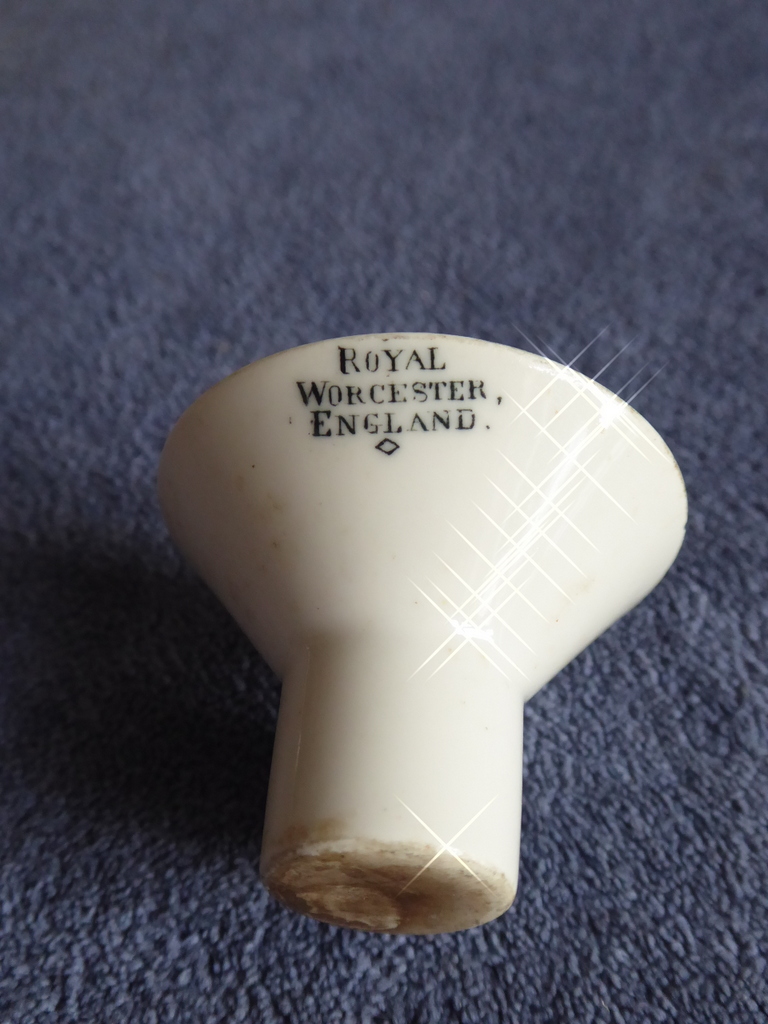 |
 |
24th July 2020 Object 4
A Victorian 3d Coin, Engraved
 |
 |
31st July 2020 Object 5
A Trench-Art Lighter
 |
 |
7th August 2020 Object 6
A Roman Coin
 |
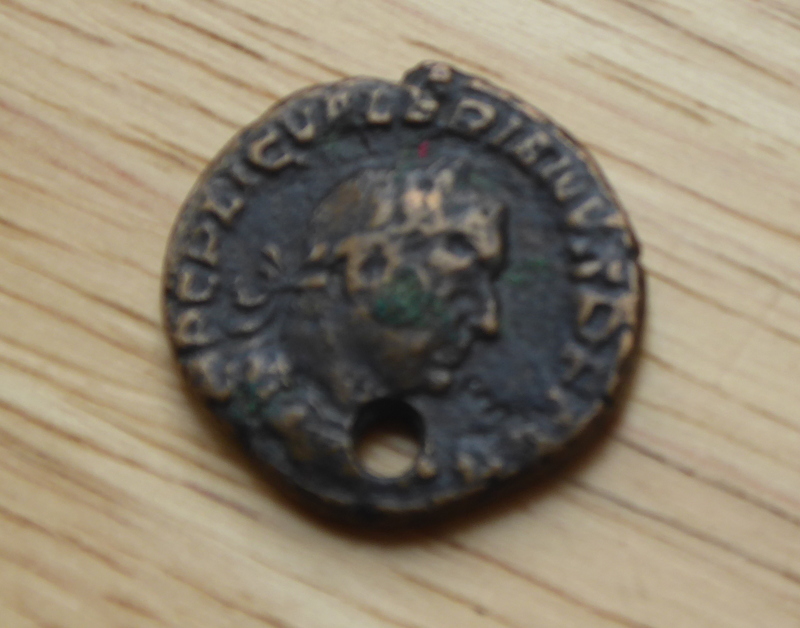 |
14th August 2020 Object 7
A Piece of Westminster Hall Roof
 |
 |
Part of the Oak Roof of Westminster Hall removed during the restoration work 1913-1922.
This roof was constructed in the reign of Richard II circa 1376 on the original walls erected by William Rufus.
The Law Courts were fixed here in 1224.
This piece of oak was in place at the Coronation of Henry IV (Bolingbroke), the trial and condemnation of Lord Cobham, of the Dukes of Somerset, Northumberland and Norfolk, also of Strafford and later of his Royal Master Charles I; all of which courts took place under this historic roof.
21st August 2020 Object 8
A Locomotive Number Plate
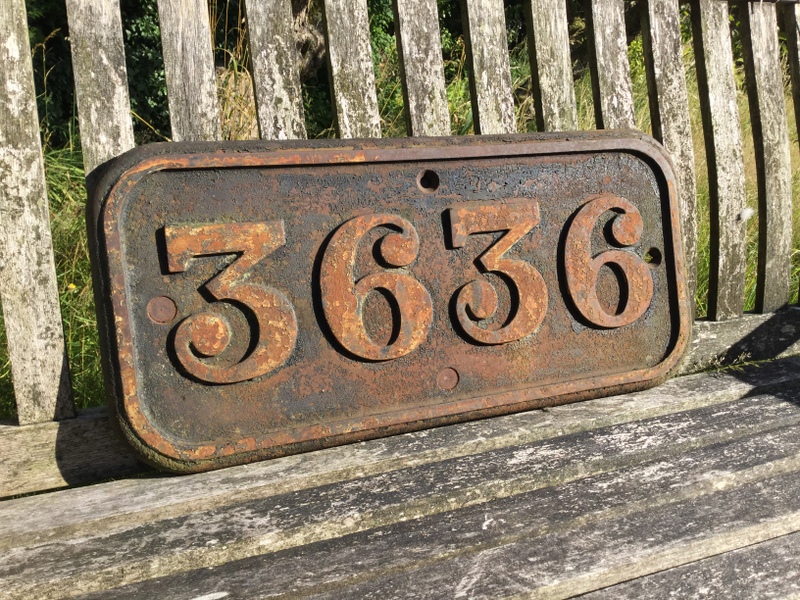 |
This unusual object has been provided by DW. It is a number plate that he retrieved from a steam locomotive. I would love to be able to say that it was from the locomotive that hauled the famous 'Master Cutler' Pullman train that used to pass through Amersham Station every morning on its way from Sheffield to London Marylebone.
But alas, it is from a far humbler engine. DW writes:
An aesthetically-pleasing numberplate from a Great Western 0-6-0 pannier tank engine. I liberated it from the Swindon Works scrapyard in, I think, 1962. The engine had been withdrawn in February that year and I brought the plate home without incident in a duffle bag (remember them?). One of a class of 863 locomotives (the most prolific on the GWR), it was built at Swindon in late 1939 at a cost at the time of £2,850. The number and borders were originally painted yellow on a black background.
Used mostly for light goods work and branch line passenger duties (including the Banbury-Princes Risborough service), 13 were acquired by London Transport from what was by then British Rail, where they operated on permanent way trains until 1971 when steam was finally withdrawn across the country. 16 of the class are preserved, including two at Didcot and one at Quainton.
28th August 2020 Object 9
An Article about a Coleshill Exhibition
Contributed by EM, this is a newspaper article about Coleshill from 1928. Because it is rather difficult to read in places, there is a transcription below the image.
 |
COLESHILL
WHAT MIGHT HAVE BEEN AND WHAT IS
At the base of the neat and satisfying war memorial at Coleshill there is the wording:
Ye that live on ‘mid England’s pastures green
Remember, and think what might have been.
Aye, what might have been! Were it not for the war, would Coleshill be as it is today? If the war had not gone as it did go, would Coleshill be as it is today? These are matters of speculation, and absorbing nature.
It is surprising that this hill village is not more visited. Perhaps the climb to it is the cause of the neglect. The climb if done upon foot or in the periodical bus is well worth while because of the lovely views from this eminence, of which the best is that Londonwards. Three things strike the visitor, or at least struck the writer. First the neatness and tidiness of the quiet God’s acre which represents also the Churchyard, a peaceful nook, which commands a beautiful valley view. Alas, so many of these places are neglected, grass-ridden, weed-run, untidy. Here the grass was closely mown and trimmed well; the flowers were beautiful; the graves tidy; and the church adjacent on a par with those things, a satisfying, pleasant whole. Second, the beautiful cricket ground the well known Coleshill Cricket Club have by courtesy of Mr Forbes. The surroundings are of the cricket atmosphere—a real bit of old England for an English game, with hill and valley in prospect, a good bit of greensward, and a handy pavilion. Coleshill has turned out some cricketers and footballers: here sport is really fostered, and as well as showing his generosity and interest of loaning this ground, Mr Forbes takes a keen personal interest in this club, as he does all the village life. The visitor did not see Coleshill top-dogs on Saturday afternoon, strange, seeing that they trounced Gerrards Cross at Gerrards Cross, but he saw some keen, close, and enjoyable cricket, enjoyed a good cup of tea (thanks to the ladies) and admired the charming views from the ground. Third, the Village Hall. A useful, well-used place, commodious and quite a centre of village activities.
There was the annual village industrial exhibition there on Saturday afternoon, and this was notable for what was to be seen and equally noticeable for what was not seen. The quality of the stuff there was excellent all round; the quantity was poor, and in a village of capable gardeners and industrious handworkers much more should have been tabled.
Vegetables and flowers were alike excellent and some of the potatoes and scarlet runner beans were of outstanding quality and size. Lady visitors found plenty to admire in the ladies’ skilled work. In the industrial section, beautiful woollen rugs were a feature—this was not ladies’ handiwork but a man’s. The children’s drawings were very fine, and it was plain from these that nature subjects are the appropriate subjects for the drawing lessons.
The Awards
The awards in the various classes were:
Writing. — Standard 5: 1, Margaret Higgs; 2, Daisy Street; 3, Lesley Wright. Standard 4: 1, Jessie Garner; 2, William Lane; 3, Phillip Slade. Standard 3 (Script Writing): Equal 1st, Pamela Haynes and Ashley Hazell; 2, Dorothy Street; 3, Romer Barber. Standard 2: 1, Dorothy Appleby; 2, Ernest Clark; 3, Leonard Attridge. Standard 1: Mary Saunders
Drawing. — Standard 6: Sidney Ware. Standard 3: Romer Barber.
Bottled Stone Fruit. — 1, Mrs Turney.
Pot of Marmalade. — 1, Mrs Barber; 2, Mrs H Appleby.
Pot of Jam. — 1, Mrs H Appleby; 2, Mrs A Saunders; 3, Mrs Chas Birch.
Bottle of Chutney. — 1, Mrs C Birch; 2, Mrs A Saunders.
Bottle of Mixed Pickles. — 1, Mrs A Saunders.
Home-made Wine. — 1, Mrs A Saunders; 2, Mrs Wingrove; 3, Mrs J Saunders.
Home-made Fruit Cake. — 1, Enid Stubbings; 2, Mrs H Appleby.
Home-made Plain Cake. — 1, Mrs H Appleby; 2, Mrs B Carter
Fruit or Jam Tarts. — 1, Mrs Barber; 2, Mrs H Appleby; 3, Mrs A Saunders.
Rock Cakes. — 1, Mrs B Carter; 2, Miss K Higgs.
Boiled Potatoes. —1, Mrs H Appleby.
Table Decorations. — 1, Mrs H Appleby.
Best Window Plant. — 1, W Dean.
Collection of Wild Flowers. — 1, Freda Slade; 2, Leslie Wright and Daisy Appleby.
Best Bunch of Antirrhinums. — 1, C Slade; 2, F Brackley.
Best Bunch of Sweet Peas. — 1, F Brackley; 2, C Slade; 3, W Dean.
Best Bunch of Roses. — 1, K W Cryer; 2, C Slade.
Underlinen of all kinds. — 1, Mary Cheshire; 2, Kate Garner.
Blouse of Frock. —1, Mrs Turney; 2, Doreen Saunders.
Crochet. — 1, Mrs Turney.
Knitted Socks or Stockings. — 1, Mrs Turney.
Knitted Jumper, Jersey or Frock. — 1, Miss G Stubbings; 2, Kathleen Saunders.
Darned Sock or Stocking. — 1, Mary Cheshire.
Twelve Round Potatoes. — 1, F Williams; 2, G Saunders; 3, S G Ware.
Twelve Kidney Potatoes. — 1, W Wingrove; 2, F Williams; 3, L Aldridge.
Nine Carrots. — 1, C Slade; 2, J F Williams.
Six Turnips. — 1, L Aldridge; 2, J Brackley; 3, B Wingrove.
Twenty-five pods of Peas. — 1, W Norris; 2, B Wingrove; 3, W Brackley.
Twenty-five pods of Runner Beans. — 1, J Brackley; 2, F Williams; 3, S Saunders.
Four Beetroot. — 1, W Dean; 2, W Brackley; 3, C Slade.
Six Parsnips. — 1, C Slade.
Nine Spring Onions. — 1, F Williams; 2, C Slade; 3, L Aldridge.
Two Marrows. — 1, J Cryer.
Two Cabbages. — 1, F Williams; 2, C Jerram; 3, W Brackley.
Collection of Vegetables. — 1, W Brackley.
Twenty-five Shallots. — 1, J Meeks; 2, W Brackley; 3, F Williams.
Six Cooking Apples.— 1, S C Ware; 2, H Muckley.
Six Dessert Apples.— 1, S C Ware; 2, J D Hatch; 3, W Wingrove.
Twelve Plums. — 1, W J Norris.
Fifty Cherries. — 1, S C Ware.
Six Coloured Eggs. — 1, Mrs J Ware.
Six White Eggs. — 1, Mrs Wingrove.
Fancy Needlework. — 1, Miss Stubbings.
Hand-made Rugs. — 1, C Jerram.
A Welcome Visitor
The organisers had the welcome assistance of Mrs Preston of Beaconsfield, who formally (or it should be said informally and gracefully) declared the exhibition open after being introduced by the Rev. F Urch. He remarked that Mrs Preston felt herself as belonging to and interested in three places—Beaconsfield, Seer Green, and Coleshill, and she was especially interested in Coleshill because some of her staff resided there, and he was pleased to say that Mrs Preston’s staff had assisted the exhibition. Mrs Preston agreed with what Mr Urch said, and offered cordial congratulations to the village upon the show, and the quality of the stuff tabled.
This exhibition had the benefit of the help and interest of the Rev. F Urch and Mrs Urch who take an unfailing interest in all departments of village life and are upon good terms with the folk there; Mr Urch acts as hon. secretary of the exhibition, with Mr E Stubbings, and Mrs S G Ware and Miss Elsie Hatch as assistant hon. secretaries, and Mr Ware as general helper. Mrs Ware, Miss Andrews, and Miss Hatch arrranged the refreshements; Messrs Jerram and Hobbs had charge of the amusements; and entertainment was provided by a five valve wireless set loaned by the Rev. F Urch.
4th September 2020 Object 10
A Hunting Horn
 |
11th September 2020 Object 11
A Vintage Pullman Carriage
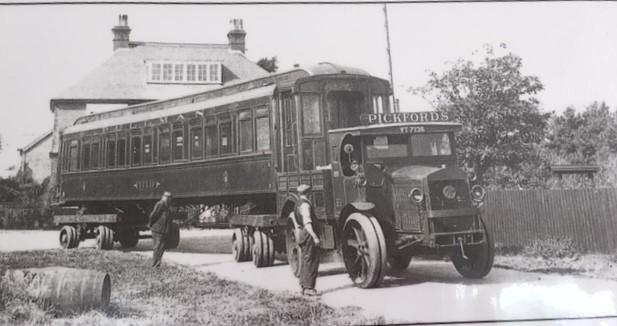 |
The picture shows the carriage being transported to East Beach. Also interesting is the tractor transporting it. It is a Latil tractor which is particularly novel in that it had four-wheel drive and four-wheel steering plus a winch which would probably been used to load the carriage. Pickfords had contracts to move munitions for the army so they probably got hold of it during the war.
We had many family holidays there as children and spent one winter there when the sea froze! My mother and her sister sold This Freedom in the 1970s for £10,000 and acquired a very modest old gypsy caravan nearby called Noah’s Ark which is still in the family. Tulip is now on the market for £1.5 million, albeit renovated and considerably enlarged! Probably not a good investment as the sea comes closer every year.
18th September 2020 Object 12
A Safety Hook
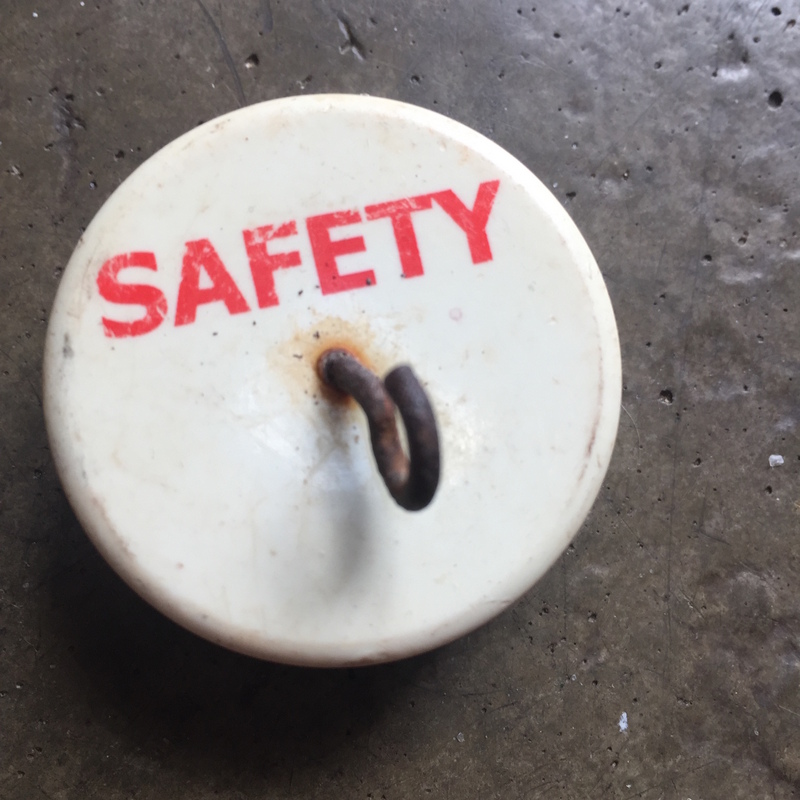 |
 |
The object was found by AD and he writes,
"It's obviously some sort of safety hook, but I haven't yet worked out exactly what it might have been used for.
Something to hang a keyring on?
It's 1.5 inches / 4cm in diameter and is backed by a strong magnet.
I found it in poking out of the soil in one of the wooded areas on the common."
25th September 2020 Object 13
Another Trench-Art Lighter
 |
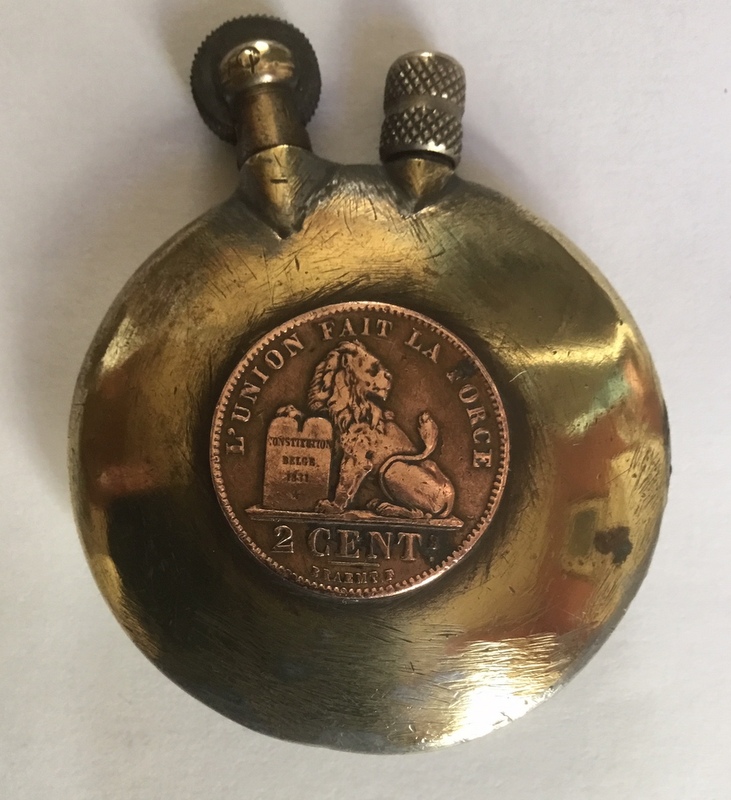 |
"An example of 'Trench Art', it was found in my RHA (Royal Horse Artillery) uncle's kit.
It was probably picked up from a trench or no man's land. He was frequently FOO( Forward Observation Officer) in which capacity he earned his MC."
2nd October 2020 Object 14
An Engraved Sea Shell
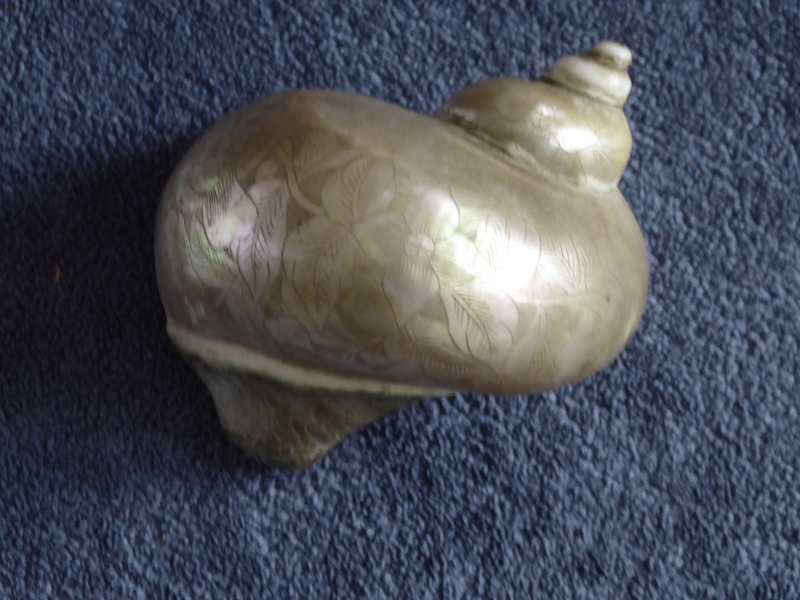 |
 |
'This engraved sea-shell was handed down in the family and dates, I think, from Victorian times. It has one remarkable property: if you hold it to your ear, you can hear the sound of the distant sea!’
16th October 2020 Object 15
An Article about the Coleshill Horticultural Show
 |
 |
WEDNESDAY, AUGUST 15, 1894
COLESHILL HORTICULTURAL SHOW.
The pretty village of Coleshill must now be numbered with those places which possess a Horticultural Society—one of the- best institutions that any village can boast of. The good that such a society is capable of doing is infinite, and we trust that the Coleshill Society will enjoy a useful and prosperous career. The first Show was held on Bank Holiday, in the Cricket Field (kindly lent by Mr. Weatherby). An excellent collection of vegetables, fruit, and flowers was staged in a marquee, the most noticeable classes being those for potatoes, cabbages, carrots, broad beans, and peas. Fruit was not very largely shown; and among the exhibits of flowers, the bouquets of wild flowers by the children deserve a special word of praise. There were 18 entries, and four prizes were «awarded, all the other competitors receiving twopence each. The entries in all the classes totalled about 180, something like 50 of which were by women and girls for needlework exhibits. We are glad to see encouragement held out in this direction, and thanks are due to the following donors of prizes:- Needlework, Miss Weatherby and Miss E. Weatherby; lace, Mrs, Weatherby and Miss M. Fawcettt; beading, Mrs. Hodgson; knitting, Mrs. Taylor and Miss Taylor. Mrs, Taylor also offered prizes for honey. Mr. D’ O. Aplin for baskets or bouquets of flowers and cooked potatoes, Mrs. D’ O. Aplin for the best flower garden. Leonard Lane, gardener to Mrs. Taylor, exhibited, not for competition, a group of flowering and foliage plants, and a collection of vegetables; H. Arnold, a gardener to Mr. Weatherby, also sent a group of plants. Frederick Shrirmpton, gardener to Mrs. Jarvis, had on view some pot plants and vegetables; and vegetables were also loaned by J. Allnutt, gardener to Mr. Hodgson, and J. Dunkley, gardener to Mr. Howland. The judges were:— Gardens and allotments, Messrs. F. Ware, G. A. Boug, W Dyaart, L. Lane, H. Arnold; vegetables, fruit, and flowers, C. Olney and G. Stacey; needlework, Mrs. Hodgson, Mrs. Taylor, Miss Weatherbv; flower gardens, Mrs. Taylor and Mr. J. E. Hodgson.
The success of the show was from every point of view beyond expectations, and the Committee are to be warmly congratulated upon the happy results achieved. Those forming the general Committee were the Rev. B. D’ O. Aplin, Mr. Weatherby, Mr. J. E. Hodgson, Mr. Evan L. Hodgson (Hon. Secretary), Messrs. A. Sears, W. Harris, L. Lane, H. Parker, G. Stacey, Ephraim Palmer, and H. Muckley. A Ladies’ Committee consisted of Mrs. Weatherby, Mrs. Taylor, Mrs. D’ O. Aplin……….
During the day a cricket match took place between an eleven captained by Mr. W. J. Fraser, of Little Miissenden, and a Coleshill eleven captained by Mr. J. H. Weatherby; time did not permit of the game being played out, and a draw (in favour of Coleshill) resulted. The attendance of visitors, who were favoured with fine weather, was very numerous, over 600 entering the meadow. Music was supplied by the Winchmore Hill Band. The prizes were given away in the evening by Miss Weatherby, assisted by the Rev. D' O.. Aplin. A list of the prize takers is appended:—
Cottagers and Agricultural Labourers.—
Coloured round potatoes—1 W. Lane, 2 W. Shrimpton. extra J. Hawke.
White round potatoes—1 W. Lane, 2 J. Hawke.
Coloured kidney potatoes—1 W. Shrimpton, 2 J. Hawke.
White kidney potatoes—1 R. Sanders, 2 J. Hawke, extra S. Sanders.
Spring onions—1 T. Turney.
Spring sown cabbage—1 S. Sanders, 2 J. Hawke, extra W. Lane.
Pickling cabbage—1 H. Sanders, 2 R. Sanders.
Turnips—1 J. Slade, 2 H. G. Muckley.
Broad beans—1 S. Sanders, 2 W. Harris.
Scarlet runner beans—1 S. Sanders, 2 H Redding.
Peas—1 W. Lane, 2 W. Shrimpton.
Vegetable marrow—1 W. Lane.
Gooseberries—1 H Redding, 2 W. Harris.
Red currants—1 W. Shrimpton.
Black currants—1 Mrs. T. Slade.
Cut blooms—1 Minnie Lane, 2 W. Dover.
Pot plants—1 Fred Lane, 2 Mrs. Palmer, extra W. Dover,
Bouquet of wild flowers (children only)—1 Bobby Lane, 2 Annie Burt, extra Annie Shrimpton and Eva Lane.
Collection of vegetables—1 W. Shrimpton.
Collection of vegetables grown by professional gardeners in their own gardens—1 F. Shrimpton.
Honey—1 Mrs. Aldridge.
Best arrangement of flowers, basket or bouquet—1 Mrs. L. Lane.
Prettiest and neatest garden—1 Mrs. Rogers, 2 H. Burnham, extra Mrs. Sawyer.
Cooked potatoes—1 Mrs. Aldridge, 2 Mrs. L. Lane.
Best cultivated cottage garden—1 W. Shrimpton, 2 W, Harris, extra H. Redding and R. Sanders.
Best cultivated allotment—1 J. Bryant, 2 – Shepherdly.
Man’s shirt made by a woman—1 Mrs. Allnutt, 2 Julia Shrimpton.
Night gown made by a girl under 15—1 Eva Sears, 2 Kate Sanders.
One yard of old Buckinghamshire lace—1 Mrs. Sears, 2 Mrs. Bunce.
Three yards of Buckinghamshire lace—1 Mrs Wright, 2 Mrs. Burnham, extra Mrs. T. Slade.
Darned stocking—1 Sarah Shrimpton, 2 Mrs. L. Lane.
Knitted socks—1 Mrs. L. Lane, 2 Annie Shrimpton.
23rd October 2020 Object 16
Brass Manillas
 |
The photo is of one complete and one damaged Brass Manilla. The former is 58mm across its widest point, and is part of my extensive collection of small objects of interest found while diving in British waters.
The early Portuguese explorers of the 1470s observed that copper bracelets and legbands were the principal money all along the West African coast. They were usually worn by women to display their husband's wealth. As European trade developed, the Manilla came to be manufactured in Portugal, Holland, France and Britain using bronze and brass, despatched with other trade goods to tribal heads and Arab dealers in the Slave trade.
I found these Manillas near the wreck site of the English Schooner "Duoro", lost on the Western Rocks of the Scilly Isles in 1843.
Extensive information om Manillas can be found in http://www.coincoin.com/I024.htm.
30th October 2020 Object 17
A Ceramic Head
 |
 |
This Ceramic Head was dug up in the late 1930s in the garden of what is now called Walnut Tree House. This garden existed in land which is named ' brick yard ' in at least one old map of the area and is immediately adjacent to the old brick kiln behind the Bottle Cottages now called Coleshill Cottage.
The old brick kiln, with easy access to water and clay, had the facilities to maintain a hotter oven than required for making bricks and is believed to have enabled the making of the glass bottles in the brick work of Bottle Cottages and could have been used to construct all kinds of ceramic objects.
6th November 2020 Object 18
An Assaying Crucible
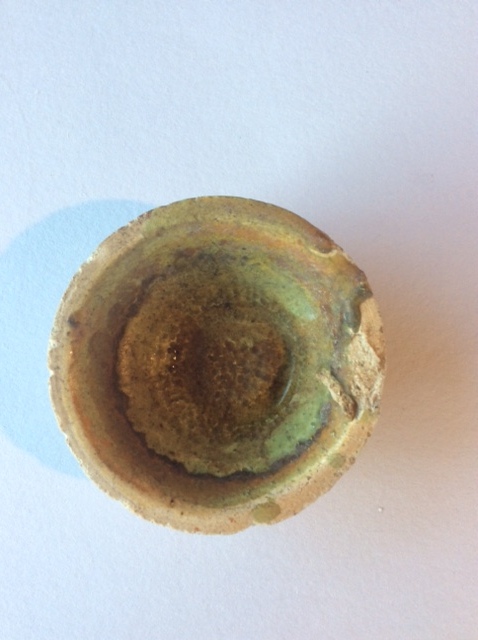 |
 |
 |
It is an assaying crucible used to analyse the quality of an ore after smelting.Made of unglazed stoneware it is stained inside from use and has a spill residue on the side, from copper in this case.Made by Battersea Works c1900. 2 1/2 is impressed on the base, and refers to the diameter of the crucible.It was found at Crotty, a ghost mining town on the rugged West Coast of Tasmania. The town is now submerged under a lake used for hydro electric power generation. In drought years the town ruins are revealed. This last happened in 2016.I trekked in with friends, through the bush, in the late 60s to the ruined town and brought the crucible back.
13th November 2020 Object 19
The Rosary Auction Notices
 |
 |
 |
These 'objects' are newspaper facsimiles submitted by EM. There is a newspaper notice for the Auction at the Rosary in 1887. Also shown is a second notice for the Auction of the associated Farm stock and effects. Finally there is a photograph of the Rosary Farm Dairy c1910.
20th November 2020 Object 20
A Cannon Ball
 |
This cannon ball was found in the Thames mud near Woolwich Arsenal during preparatory surveys for construction of the Thames Barrier.It’s five and three quarter inches in diameter and weighs seventeen and a half pounds.
Almost perfectly spherical, it would have been made by dropping a measured quantity of molten iron from about Eighty feet into a deep vat of cold water, which had the effect of rounding off the natural “drip” shape of the falling metal into the ball shape.
Probably dates to about 1750.
27th November 2020 Object 21
A Steam Pressure Gauge
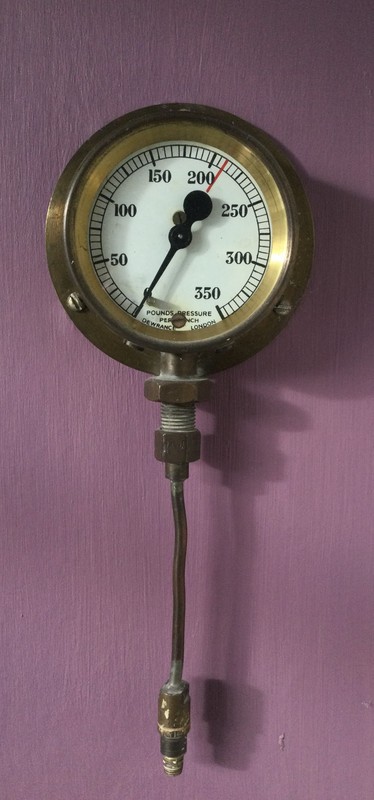 |
 |
It’s a steam locomotive’s brass boiler pressure gauge manufactured by Dewrance and Co. – a firm established in 1835 and still operating in Skelmersdale. An important supplier to the early locomotive-manufacturing industry, including George Stephenson, they also provided Lloyds of London with equipment to test ships’ boilers before insuring them.
The page from an 1876 catalogue shows this particular model sold for 22s/6d. It was owned originally by Ewart Smith of Wheatsheaf Cottage and (probably) used in one of his miniature steam locos, occasionally to be seen running on the track in his garden.
4th December 2020 Object 22
Handmade Brass Nails
 |
These objects have been submitted by LT. Here is his description:
These are handmade brass nails from the wreck of an 18th century cargo carrying sailing vessel wrecked off the coast of Northern Ireland.
Each nail is about 3cm long. Hundreds were used to secure sheets of copper over the whole underside of the ship to protect the timber structure against damage by Teredo worms and other marine boring creatures.
The shank of every nail was individually filed to a sharp square point with around flattened head.
11th December 2020 Object 23
A Certificate signed by Queen Victoria
 |
18th December 2020 Object 24
An Air Raid Shelter Safety Lamp
 |
Originally painted khaki or drab brown, these cast aluminium alloy lamps were issued to WW2 Air Raid Wardens for providing dim, but safe illumination in public air raid shelters where electric lighting was unavailable.About 8 inches (200mm) high, the lamp is fuelled with paraffin. The sloping sides of the burner compartment are surfaced with fine brass wire mesh,which, just like the Davy lamps developed for use in coal mines, allowed their safe use in areas where bomb damage had resulted in fractured gas mains. Any open flame would have caused the gas to explode.The simple utility design of these lamps generated little interest from collectors of war memorabilia, making them quite a rarity. These simple devices would have helped to save many lives during the blitz.
1st January 2021 Object 25
Woodworking Tools
 |
 |
 |
These are not rare tools - a try plane, rebate plane and marking gauge. I brought these tools in about 1960 from a advert in the Bucks Examiner. These came from a C ROCHESTER who had died (he was in his eighties).
He had been a shop fitter carpenter. In his tool box there was about 50 moulding planes, chisels and screwdrivers. All the tools had his name stamped on them and it must have took him a long time to do this. I still use the planes. I hate think how old they are!!
8th January 2021 Object 26
A Bone Letter Seal
 |
 |
This small object has been in our family for at least two generations. However its origins are somewhat of a mystery. Who owned this seal?
The shaft is made of bone with a brass head which will twist off. The letter H is incised on the head. Given its small size it is reasonable to conclude that it belonged to a woman.
The most likely candidate is a Helena Beatrice Morse (nee Cleland) who was born in 1897 in a tiny country settlement on the east coast of Tasmania. A distant cousin, but we share a first name!
15th January 2021 Object 27
Sarsen Stones
 |
 |
Sarsen Stones
Just before Christmas I was walking in Chorleywood with a friend who was one of the authors of a book on the history of Chorleywood and she pointed out some large interesting stones in Old Shire Lane where it runs through the ancient woodland of Philipshill Wood. They are called Sarsen Stones and are of red sandstone. They are thought to have been boundary stones between the Saxon Kingdoms of Wessex and Mercia or possibly between Hertfordshire and Buckinghamshire. They appear geologically alien to the area. However they originate from the Paleogene sediments which once covered the chalk in this region. These sediments have long since eroded away, leaving behind these resistant siliceous rocks.
Sarsen Stones are also found in quantity on the Salisbury Plain and the Marlborough Downs in Wiltshire. Sarsen is short for Saracen which is a common name for Muslims or by extension for anything non-Christian or Pagan. They were used for the Heelstone and Sarsen Circle Uprights in Stonehenge and Avebury in about 2000BC.
22nd January 2021 Object 28
The King Inspecting Troops, WW2
 |
 |
 |
 |
 |
 |
 |
29th January 2021 Object 29
Irish Bond Certificate
 |
This unusual object has been submitted by DW.
Republic of Ireland Bond Certificate
During the Irish War of Independence (Anglo-Irish War if you wish) the Republican side raised funds both at home and in the US. Eamon de Valera, born in New York, went back there on a fund-raising drive in 1919 (having escaped earlier that year from Lincoln prison). He raised over $5 million in all by means of these bond certificates – so named to avoid any accusations of fraud, as they couldn’t be traded like an ordinary bond. It was made quite clear to investors that what they ‘invested’ was by way of a gift. As and when the Republic of Ireland gained international recognition they could be exchanged for so-called Gold Bonds paying 5%. This of course never happened.
The $10 denomination was the commonest, but $25, $50, $100, $1,000 and even $10,000 were also available. This particular example, no. 210877, was never actually sold to a subscriber (if it had been, a name would have been written in after ‘To…’). Once independence was won in 1923, ownership of the funds raised was disputed between the anti-Treaty side in the Civil War (led by de Valera) and the new Free State government. The Irish Supreme Court awarded half to the latter immediately but the other half remained in escrow in New York until that state’s Supreme Court determined in 1927 that the monies should be returned to the original subscribers. The possibility of so doing ended in 1936 with the passing of the relevant Act in Ireland.
Some would say that de Valera was perhaps the long-term winner, becoming Taoiseach in 1932 and, later, President until 1973.
5th February 2021 Object 30
Plumbing Irons
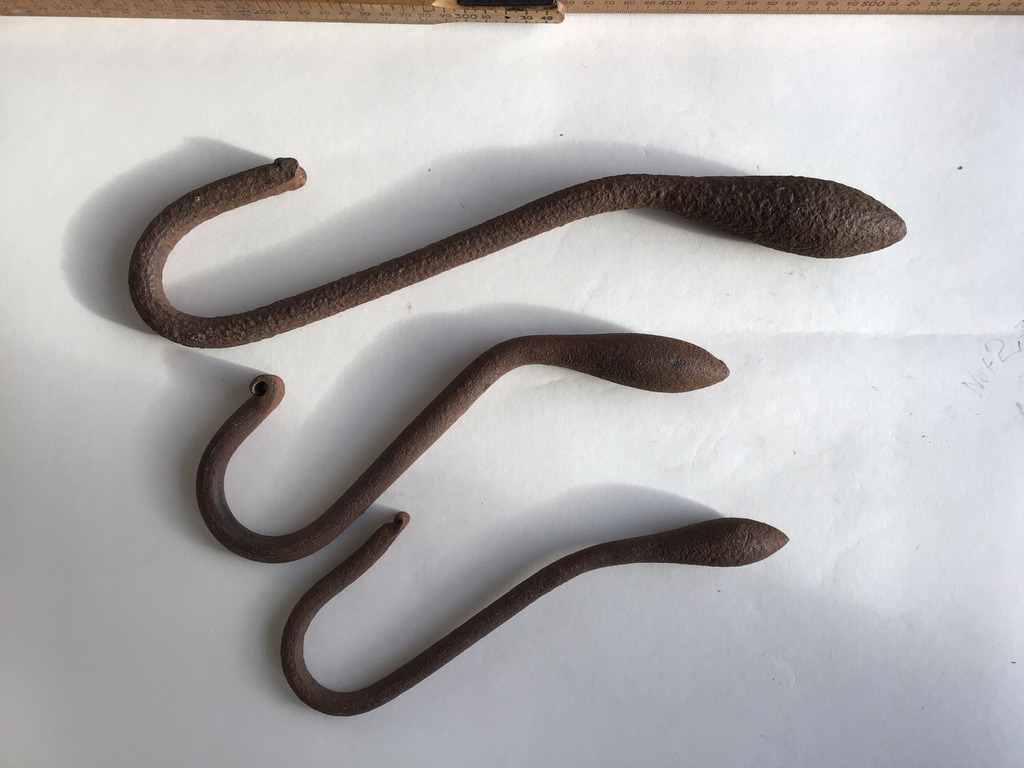 |
You will know that the term “Plumber” was originally a tradesman skilled in the use of lead for covering and weathering roofs, rainwater gutters and pipe work for many and various uses, particularly, but not only related to building works.
The three example objects illustrated here were used by plumbers until late Victorian times prior to the invention of portable paraffin fuelled blow lamps and bottled gas burners. Being of heavy wrought iron they were used in conjunction with a roaring hot coke brazier. Called “puddling irons”, they came in sets of ten or a dozen in ascending sizes and weights ranging from about 8 ounces to roughly five or six pounds. Of those shown, the largest weighs about two and a half pounds, just over one kilo, and is roughly 14 inches, or 350mm long.
The bulbous ends of a whole set of irons would be hung inside the brazier until they were white hot, then a heavily gloved, leather protected apprentice would quickly load them in order of size along a stout shoulder pole, and rush up the ladder to where the plumber would use each iron in turn, starting with the smallest, to form ripple-welded, watertight joints in the sheet lead roofing, guttering, or pipework.
The largest irons were used last as they held their heat longest. A high degree of skill was required to ensure the hot irons did not perforate the sheet lead. The process of melting lead for joints and fixings was called “puddling”, hence the name given to the irons. It is easy to understand why in those times, apprenticeships in the plumbing trade usually exceeded ten years.
12th February 2021 Object 31
Pudding Stones
 |
 |
This unusual object has been provided by FN. Here is his description:
Pudding Stones
I don’t know if your readers are familiar with these stones. They common in this area. The only other place in the world where they are found is Michigan USA. There are some at Lee and Cholesbury Common, big ones!! The one in the picture I picked up at Latimer. It shows the bottom and the top (which I cut and polished). If you walk from Latimer up Church Lane the first field on the left has dozens of them all around the field of different sizes.
26th February 2021 Object 32
A Fireless Cooker Handbook
 |
 |
 |
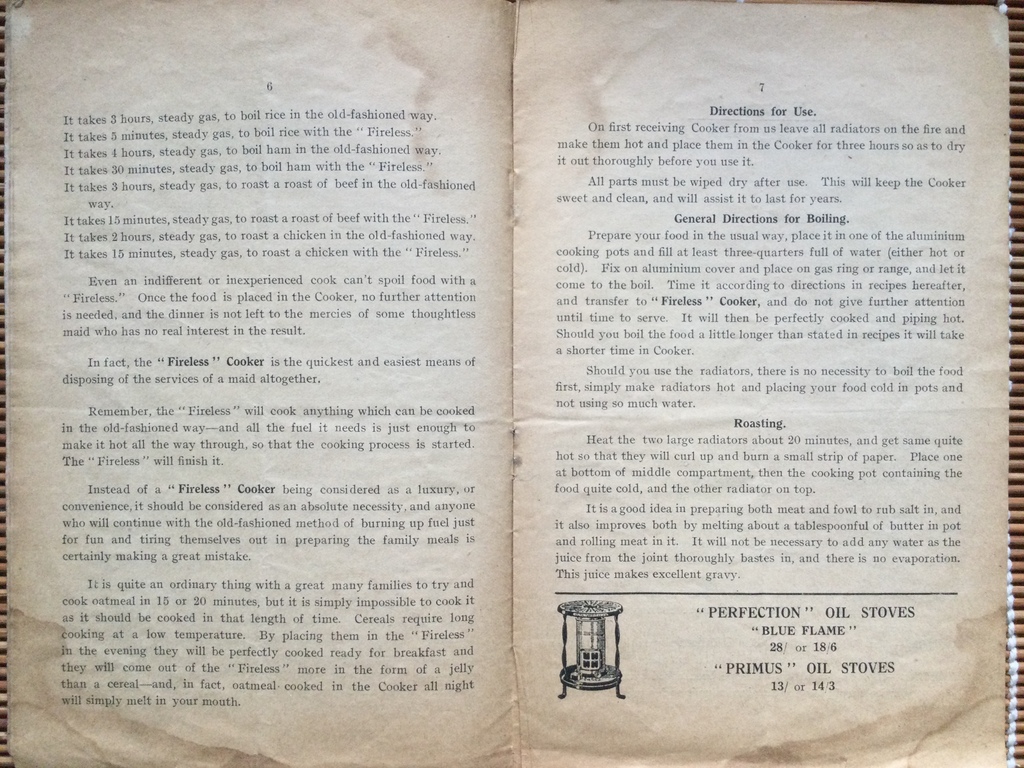 |
 |
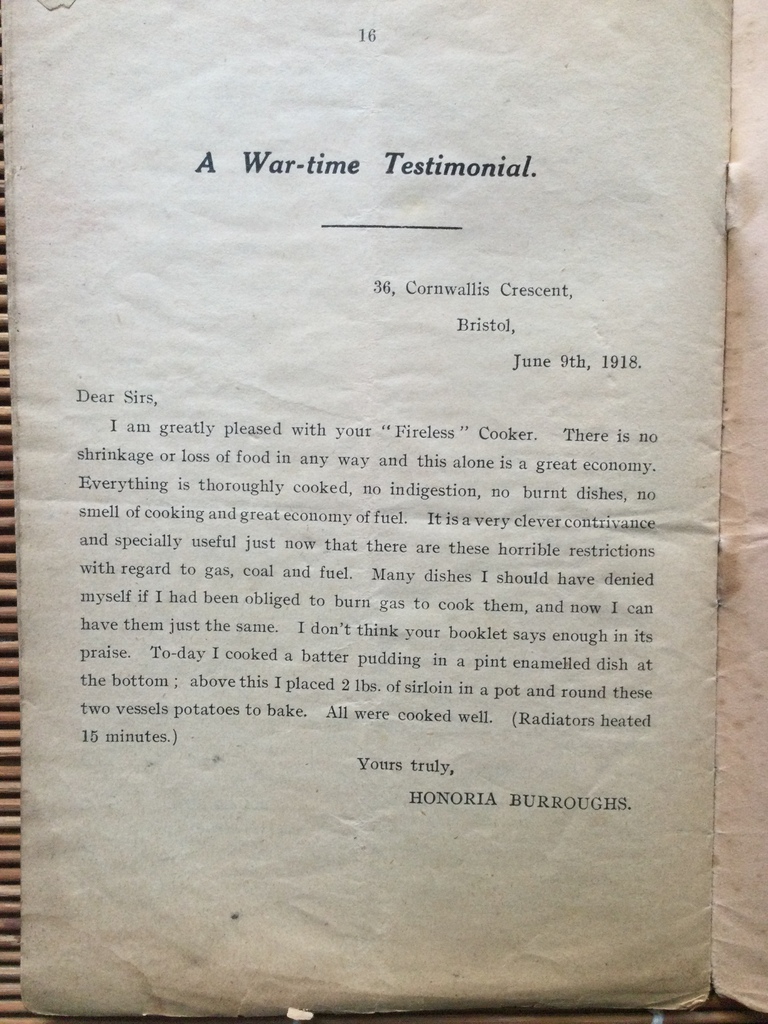 |
 |
I found this leaflet at the back of my grandmother's recipe book (not the printed kind - her personal collection of recipes, all meticulously written and saying who the recipe came from!). It's for some kind of slow cooker. The frontispiece amused me. The second photo shows the cookers.I don’t know the date she acquired it but somewhere between the two wars. The last page has a letter of appreciation dated 1918.
5th March 2021 Object 33
A Pocket Watch
 |
 |
 |
This battered pocket watch was recently lent to me by a cousin.The inscription inside reveals it belonged to my maternal great grandfather George Rose Burton. It was a gift from his brother, Edmund Charles Burton (E C B) of Daventry, who was twenty years older and head of the family. As the youngest of 16 children George Rose had been sent to Australia to make his way in the world. The hallmark of 1876 suggests that the watch may have been a wedding present, as George Rose married in February 1875, or it marked the birth of his son in December that year (news of both events reaching England reliant on ships).
The watch was intriguing as the hallmarks reveal that the case was made in England in 1876 by Aaron Lufkin Dennison of Handsworth in Birmingham. However the movement was manufactured by the American Waltham Watch Company (also known as the Waltham Watch Company) just outside Boston. The inscription reads A M Watch Co. Marlyn Sq. Waltham Mass. Fogg’s Patent. and a serial number 101701.
Research revealed that the Waltham Watch Company had been established in the 1850s by Aaron Dennison with two colleagues but he left the company in 1862 and moved in 1871 to England via Switzerland. Given that both the English and Swiss manufactured excellent watch movements he decided to concentrate on producing watch cases. However, he must have also imported movements from his old company in the USA, which had pioneered the use of interchangeable parts to keep cost low.
12th March 2021 Object 34
A Cutlery Set
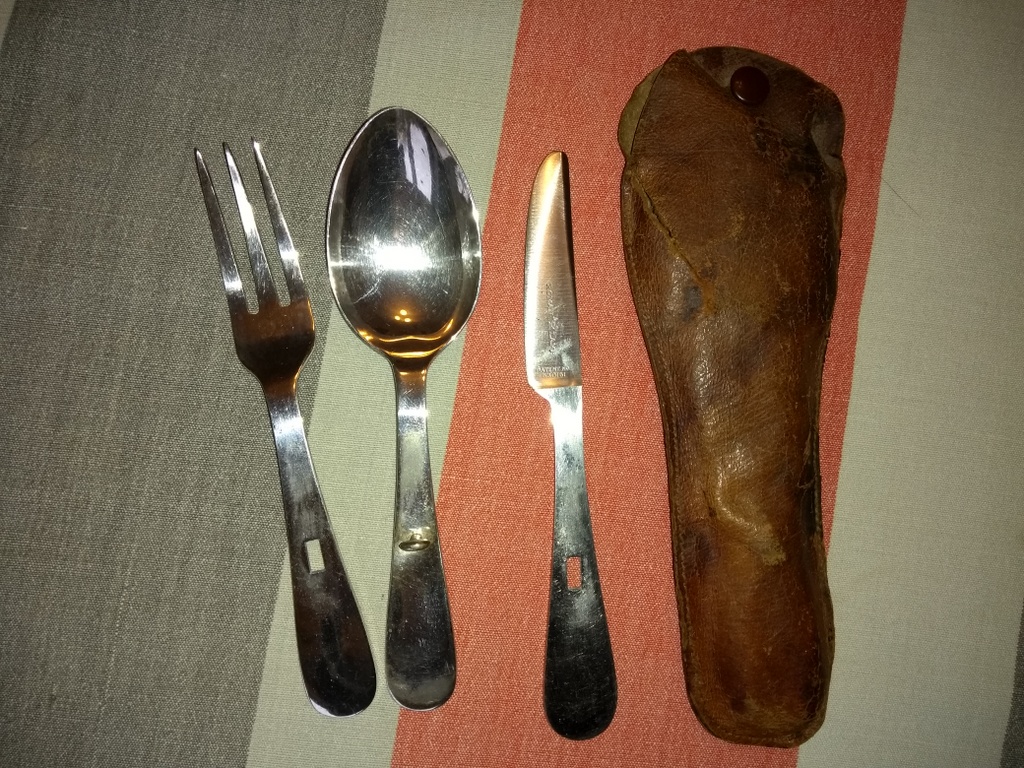 |
19th March 2021 Object 35
A Newspaper Article
This 'object' is a newspaper article submitted by EM. The article is from the Bucks Examiner dated February 3rd 1933. Because it is a little illegible in parts, it is transcribed below the image.
It brings a cold chill to think what might have become of our beautiful common!
|
|
COLESHILL
PLAYING FIELD FOR THE VILLAGE
COMMITTEE FORMED
Elaborate Scheme Mentioned at Public Meeting
An elaborate scheme for the conversion of Coleshill Common into a playing field was mentioned at a public meeting at the village hall on Friday evening.
Mr F Stubbings was voted to the chair, and Mr W J Young was asked to be secretary.
There was a decided variation in the views expressed, and the various problems confronting the meeting included:
Did the populace want a playing field?
To whom did the common belong, and had the parishioners any right to interfere with it?
Could the necessary money be raised and if so how?
The matter of upkeep if the playing field became a reality.
It appears that correspondence has passed between the Parish Council (who point out that they have no powers to carry through such a scheme) and certain people who want to see the ground laid out.
After various suggestions had been made (some with a certain amount of heat and a "you'll never do it" attitude), Mr D Payne, a local man, said he would be willing to "make a fair offer"—level as much of the common as would be required, and make: a bathing pool near the spring which would "never be empty as long as any of us live"; "as pretty a football ground as anyone ever saw"; "as fine a cricket pitch as any recognised player would want to play on"; and "as pretty a tennis court as ever was seen". He would do this for £250, and then leave £40 behind for a year's maintenance.
One member, Mr W Lane,(who was subsequently admitted to the committee) surprised everyone present during the discussion as to where the money was to come from by saying he knew of certain people who would subscribe. To use his own words, this was the position: "There are firms and people who have 'bags of money' which they want to give away for such things. Will you let me write to them, and ask each of them for £100. I'll ask for plenty, and perhaps I'll get a little—say £30 or £40. I will not tell you who these people are, but I'll show you their replies when I get them, and I'll guarantee that they will help us."
The necessary permission to write the letters was given to the speaker.
It was recalled during the discussion that several years ago when a scheme was suggested, and money collected, the people were asked which they preferred—to spend the money on the common, or have a dinner?—they had the dinner!
Mr Jerram said he was anxious to see "somewhere for the kiddies to play."
The committee appointed to go thoroughly into the matter and report to a further meeting was: Rev F Urch, Messrs F Stubbings, W J Young, F Eliot Howard, W Sears, W Lane, and H G Muckley.
The committee will hold their first meeting this (Friday) evening.
===end of article===
26th March 2021 Object 36
Mystery Items
The objects shown below were provided by LT. The items were later put on display at the Horticultural Society show in September 2021. Visitors to the show were invited to guess what the objects were used for, with a prize given for the nearest guess.
You'll see the solution to the mystery when you scroll past the images.
 |
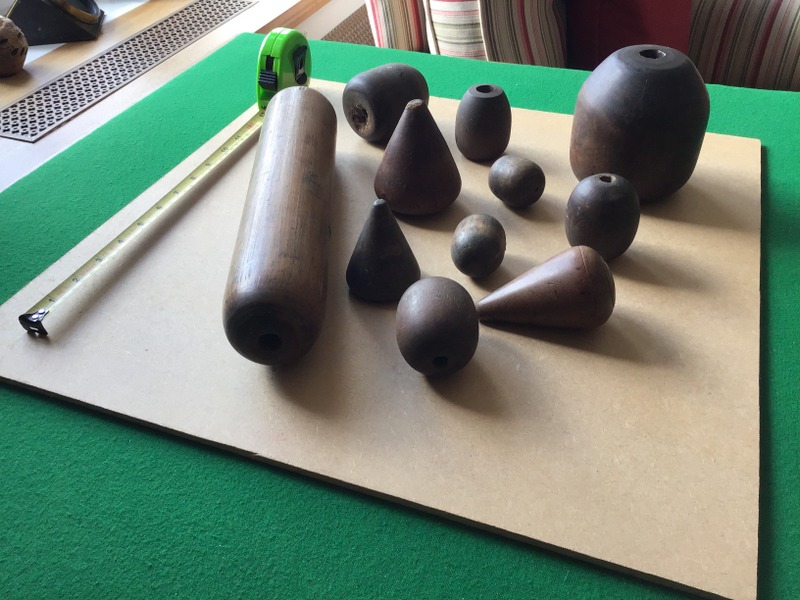 |
The competition produced more than 40 entries and, luckily for the organisers, only one person came up with the was correct answer.
Several people guessed that the objects had a range of uses in the textile trade, for making and shaping fabrics, including felt for hats and other fashion articles. Other ideas included something from a ship’s rigging, cookery shaping tools, clock weights and other parts of clock mechanisms, spinning tops and similar toys. It was very interesting to see how well people applied their imagination to assessing possible uses for unfamiliar objects.
The correct answer was ‘Victorian Plumber’s tools for shaping and jointing lead pipework’.
2nd April 2021 Object 37
A Silver Tankard
 |
 |
 |
 |
Family Farming Heirloom
This handsome silver tankard is a family heirloom but unfortunately is with my brother in California.
The inscription reads:
Bath and West of England Society
To the Revd. William Quartly,
Being a Premium for producing the
Best lot of Neat – Cattle for General Stock
At the Annual Meeting 1796
(Note: Neat is an old English term meaning domesticated cattle)
Henry, William and Francis Quartly were brothers, three in a family of 12 children. Henry was my great great great grandfather. They came from a long line of West Country farmers and farmed Ruby Red Devon cattle in a village called Molland in North Devon on the edge of Exmoor.
William was also the Rector of Molland. Francis was famous for improving the breed, refusing to sell his best specimens and outbidding the butchers to acquire the best representatives of the old breed, thus founding the Champson herd.
These Devons were the first to be introduced to the western United States to replace Texas Longhorn. The original of the portrait of Francis with Red Devon cow Betty and her bull calf was in the Farmers’ Club in London. William and Francis were unmarried and the farm passed to Henry’s son, James. I visited Great Champson, the farm at Molland, in the summer of 2019 and also the church where a lot of the Quartlys are buried.
The article came from a feature on British Cows in Country Life.
9th April 2021 Object 38
A Ship's Model
 |
 |
 |
This is a half-ship model – about 30” long and made of mahogany or a similar wood. A student friend who lived in Appledore Devon, generously gave it to me at the end of a holiday we shared back in 1955.
He had picked it up on the fore-shore at Appledore, where it had been thrown from the small ship-building yard there. It is a model of a tug and one can see all the steel plates marked on it as a guide for the cutting floor.Closed for a few years, Appledore Shipyard has undergone a renaissance and has been transformed by a covered area with enormous doors, where parts of naval ships have been constructed recently, away from prying eyes.
16th April 2021 Object 39
A Glove Case
 |
 |
 |
This brass framed, polished leather case has an expanding lower compartment which could hold as many as a dozen, even twenty pairs of light lace gloves.
The Ivory tongs are for opening out each finger of the delicate, close fitting gloves.The blue silk lined case is dated at about 1830, but unfortunately bears no maker’s mark.
23rd April 2021 Object 40
A Tankard
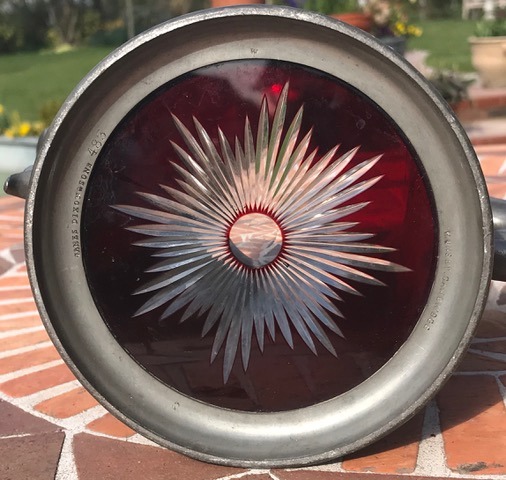 |
 |
 |
 |
 |
This tankard has been handed down from my Grandfather. It commemorates him coxing the Clare College Eight to a win in 1872. It was made by James Dixon and Sons of Sheffield which was founded in 1806 and was noted as silver & pewter manufacturers.He achieved a second in classics at Cambridge. He went into the Church and teaching becoming head of Queen Elizabeth Grammar School Kingston on Thames eventually becoming rector of Patrington in Yorkshire.His last parish was Charlecombe in Somerset where he is photographed, possibly during WW1, standing in the porch with his wife Kate nee Middlemore-Whitard who allegedly was related, though distantly, through her mother to the Duke of Orleans. The bowler hatted groom is Dexter.
The tankard has a very fine brilliantly coloured and etched glass bottom and is quite weighty even when empty.
It maybe of interest though not very valuable.
2nd May 2021 Object 41
A Ginger Beer Bottle
 |
7th May 2021 Object 42
Coleshill Fête Poster/Publicity
 |
 |
The first image is provided by IM. He wondered if it might be too risqué for modern sensibilities as it includes a drawing of a scantily clad somewhat buxom young lady. So I hope no one is overcome with a fit of the vapours.
14th May 2021 Object 43
A Polo Cup
 |
Ranelagh The Subalterns Gold Cup 1937
 |
21st May 2021 Object 44
A Theodolite
 |
 |
 |
This is a Surveyor’s Vernier Theodolite made by Chapman of Holborn in about 1710.
The remarkable accuracy of this instrument is capable of reading angular measurements between fixed points both horizontally and vertically to within twenty seconds of one minute of one degree.
Weighing 7kilos( 11.25 lbs), the Theodolite is framed in solid brass with finished in brown non-reflective varnish. The four-screw levelling base plate arrangement was used for setting the instrument accurately to the horizontal axis while the floating magnetic needle served to align measurements to magnetic North at the point of observation.
28th May 2021 Object 45
A Bottle of 'Princes Brew'
 |
 |
 |
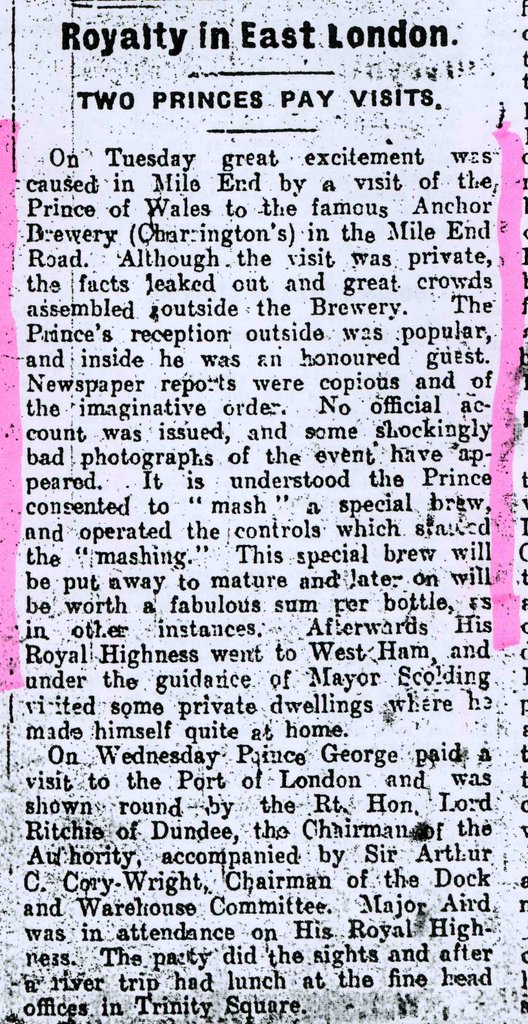 |
This bottle of "Princes Brew" is a family heirloom that Babs inherited from her mother. The unusual bottle of beer was brewed by the then Prince of Wales (later King Edward VIII). The photograph shows him "mashing" the brew (or at least turning the lever that started the mashing process) at Charington's Anchor Brewery in Mile End.
We obtained the accompanying newspaper article in the days before t'Internet. We visited the Colindale Newspaper Library and tracked down the above article from the City and East London Observer dated Saturday March 19th 1932.
The actual bottle had belonged to Babs's great-aunt, Auntie Flo as she was known to the family. Auntie Flo was married to a man called Arthur Boulanger (his real name was Baker but he changed it by deed poll to make himself sound posher!). Arthur worked as a waiter at the Café de Paris where the Prince of Wales and his entourage were regular visitors. On the evening of the 15th March, the prince having performed his official duties of mashing the beer and visiting the East End poor, he attended the Café de Paris with his usual group of friends. With him he brought a couple of cases of his 'Princes Brew' that he distributed to the waiting staff. That, at least, is the family yarn. Babs recounted it to Michael Aspel in a 2007 edition of the Antiques Road Show.
This wasn't the first occasion that the Prince of Wales had turned his hand to beer mashing. In 1929, he famously performed the same operation at the Bass Brewery in Burton on Trent.
4th June 2021 Object 46
An Original Ordnance Survey Map
 |
 |
 |
 |
11th June 2021 Object 47
A Pair of Binoculars
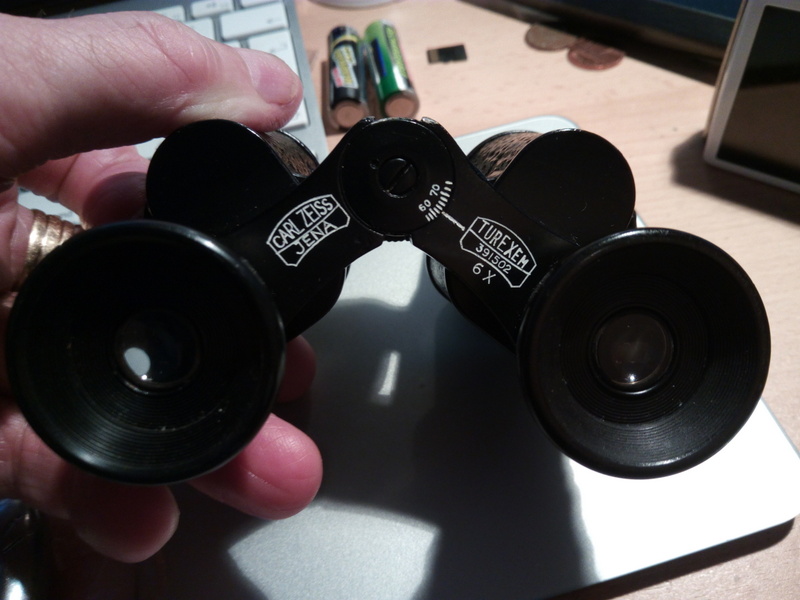 |
 |
 |
 |
https://www.coleshill.org/history/memories/a-conversation-with-pam-appleby.html
The name 'Schwann' is mentioned near the bottom of the page in a section headed 'Additional Note by Peter Helps'.
18th June 2021 Object 48
An Edison Cylinder Record
 |
 |
 |
 |
 |
This is an Amberol Blue wax cylinder, for use on a ‘phonograph’, invented in the USA by Thomas A. Edison, who is better known for having invented the light bulb.
The phonograph — ‘sound writer’ — dates from 1877 and was the forerunner of the gramophone. This was Edison’s first major invention and, being the first device to both record and play back sound, was revolutionary.
The vast majority of wax cylinders that survive today feature musical performances, although Edison’s original intention had been to find a way of recording telegraph communications and to come up with a ‘talking machine’ that could automate speech for the new-fangled telephone, which had been patented by Alexander Graham Bell the previous year.
The wax cylinder’s heyday was the 1890s, and the double-sided flat disc, introduced by Columbia in 1908, heralded its decline. By 1915 the cylinder and the phonograph had all but been superseded by discs and the gramophone.
The cylinder illustrated here features an English music hall song by George Formby, ‘the Lancashire comedian’ and father of the more famous ukulele player. Formby Senior was a very likeable, gentle comedian whose stock-in-trade was self-deprecating humour. He was huge star in the days before radio, and when he died prematurely in 1921 his appointments diary was fully booked for another seven years. He left over £21,000 in his will, the equivalent to over £2,500,000 today.
George Formby Senior made nearly 200 recordings, beginning in 1906, and this one, ‘When Father Said He’d Pay The Rent’, was released in 1911. It was the third to last of his Edison cylinders, almost all which were made from standard black wax. But this rare example is his only known recording on Edison’s trademarked ‘Blue Amberol’ system that promised increased durability and a longer shelf-life. It wasn’t actually made from wax at all, but from a bright blue celluloid (plastic) film over a plaster of Paris core. These days, over a century later, it no longer looks blue, and this example is housed in card box from a few years later (although its lid is original). Needless to say, like all wax cylinders, it is now extremely fragile and even more prone to accidental breakage than the notoriously brittle 78rpm shellac records that replaced them.
And here is George Formby Senior singinging ‘When Father Paid The Rent’:
25th June 2021 Object 49
A Violin
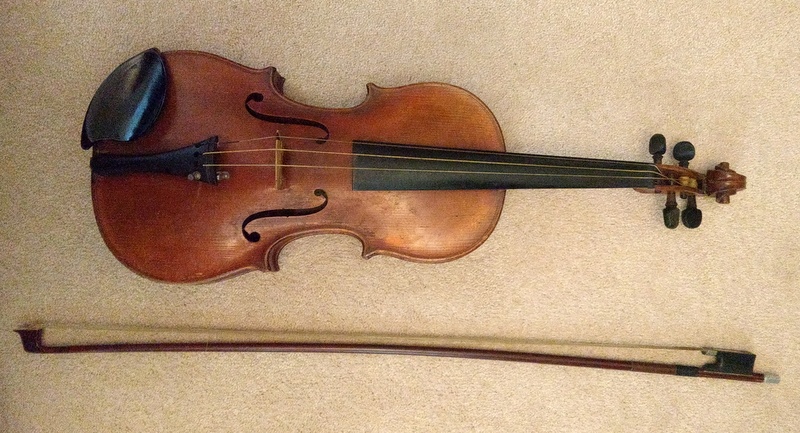 |
This is the violin I was given for my eighth birthday. While other children were given toys as presents, my father always got me something useful, or practical, or educational. And in 1956 it was this violin - which was purchased second-hand through the small ads in the Harrow Observer.
There was a frisson of excitement when we got it home. A family member using a torch and magnifying glass peered through the 'F' slots where the sound comes out. Inside they discovered a yellowing label that read,
"Antonius Stradivarius Cremonensis Faciebat Anno 1713".
But sadly the thrill was short lived because at the bottom of the label in smaller type it said,"Made in Czechoslovakia".The violin had actually been mass-produced in a Czech factory in the twentieth century and the label simply meant that the violin have been manufactured to a Stradivarius design from 1713. Such violins were nevertheless faithful copies of the original and and they are now quite well regarded in their own right.
Having had a few lessons and inspired by my virtuosity, one Sunday afternoon I took myself and my violin to visit Judy Townsend, a girl who lived down our road. And there I treated her to a performance of my entire repertoire.
Now Judy's father Mr Townsend was normally a mild mannered even-tempered sort of chap. But they say everyone has their breaking point and D's Cacophonic Variations were to be Mr Townsend's. Eventually when he could stand it no longer, he grabbed me by the hand and frogmarched me back home. There he presented me to my own somewhat bemused father with the words, "I believe this is your offspring". I think this was his way of conveying his displeasure whilst maintaining a modicum of politeness!
 |
 |
2nd July 2021 Object 50
A Champagne Bottle
 |
 |
 |
This unusual object has been submitted by PH. His contribution was inspired by a recent 'object' - the bottle of beer 'brewed' by a previous Prince of Wales. PH has in his possession this commemorative bottle of Champagne dedicated to the present Prince of Wales. Here is his amusing description.
The Object is a bottle of 1975 vintage Veuve Cliquot Champagne, the Cuvée having been selected to honour the marriage of H.R.H the Prince of Wales with Lady Diana Spencer (as printed on the bottle)
such GREAT EXPECTATIONS
ultimately tragically delivered the COUP de disGRACE by cunning, greedy, fraudulent, utterly unscrupulous, reckless, mischievous, and possibly unwittingly malign BASHIR and the BBC.
9th July 2021 Object 51
A Cane and Snuff Box
 |
 |
 |
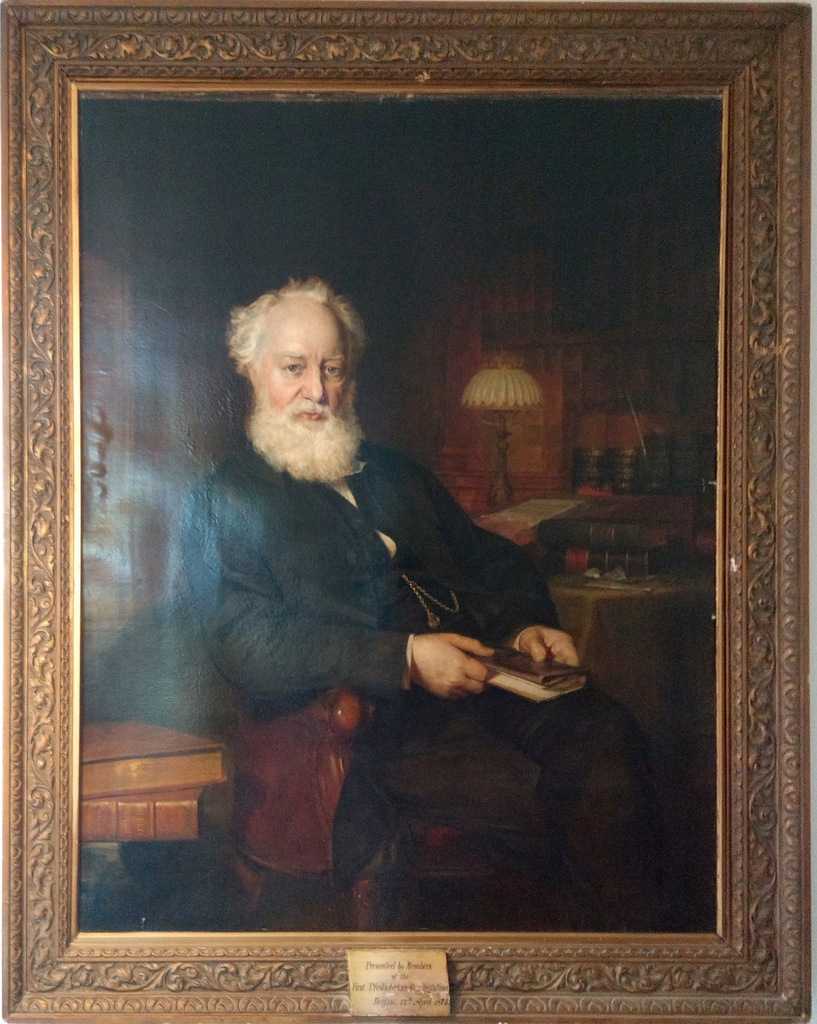 |
Personally he was a man of broad and genial nature, of strong feelings easily roused, capable of passion, but incapable of malice; in society a most genial and warm-hearted companion, rich in anecdote, fond of music, and capable of singing a good song. His somewhat gaunt figure was dignified by a striking countenance, mellowed in old age, and graced with a profusion of snow-white hair and beard.
23rd July 2021 Object 52
A Reel of Film
The Rise and Fall of Kingsbury County Grammar School
This film dates from 1967, the year of my A levels. In the short period between finishing my exams and the end of term, I made this film.
Of course, cinematography was very different in those days compared to now. With current technology, you could record all your scenes on a mobile phone in a day; edit them together on a computer in the evening; and have the whole thing finished and published on YouTube the following day.
But back in 1967 it was all very different. Scenes had to be recorded on film and audio was added later. I used a Kodak ‘Brownie’ 8mm movie camera, very basic and powered by clockwork.
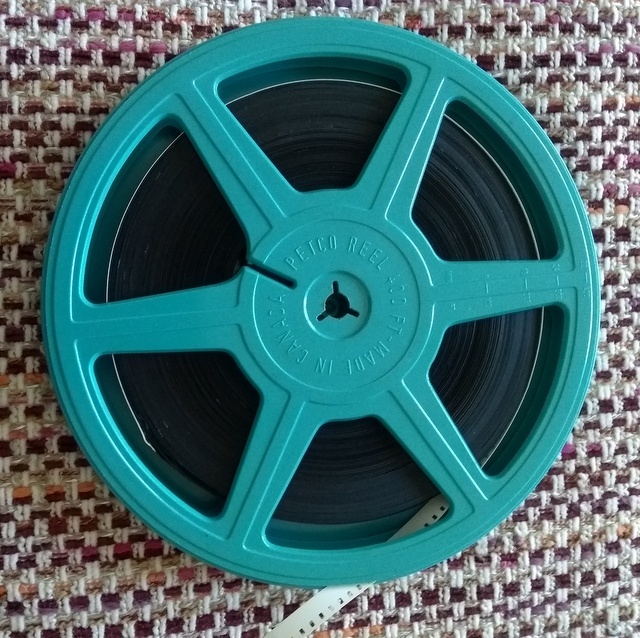 |
 |
The film had to be sent away to Kodak to be processed and with luck it was returned to you in about a week. Then the film had to be cut up into individual scenes using scissors; and then the scenes were assembled into the correct order using a splicing contraption that scraped the emulsion off the film end before applying glue to make a joint. And then a soundtrack had to be recorded and edited using a similar process with reel to reel audio tape.And there were some other interesting techniques used. For example, to make the title sequences, the background scene was filmed; and then the camera was taken into a darkroom where the film was rewound, and then the film was then exposed a second time to superimpose the titles onto the background. And for the fades between scenes, you could buy a bottle of ‘cine-fade’ in you local photography shop. This was a black dye that slowly diffused into the film. So before you spliced the scenes together, you gradually lowered the film end into the bottle to create the fade effect.
So you can see it was quite a feat of organisation to complete the film in the timescale I had.
The film itself is a gentle comedic portrayal of the transformation of my grammar school into a bog standard comprehensive, as Alistair Campbell might have called it. I don’t quite remember what inspired me to make the film but maybe it was the very occasional mutterings of some teachers who disapproved of what was taking place.
The last day of the grammar school coincided with my own last day at school. So on that final afternoon we all trooped into the school hall for the concluding end of term assembly and sang, ‘Lord dismiss us with thy blessing’; and then I invited everyone to come to a viewing of the film. Despite poking fun at the teachers who appeared in it, it was generally well received and I was even invited back the following December for a second showing.You won't get al the allusions in the film that play on teachers' names and nicknames and idiosyncrasies. But nonetheless, I hope you will savour this reflection of a bygone age.
So with apologies for the quality, here it is
30th July 2021 Object 53
A Spice Box
 |
 |
This old spice box stood on the mantle-piece over the kitchen stove when I was a child. I think the origins must have gone back to my grandmother, which would take it to the end of Victoria’s reign. It is as cheaply made as could be imagined but, miraculously, it still has the smell of cloves and nutmeg in two of the drawers.
6th August 2021 Object 54
A Milk Bottle
 |
This was found deep in the grass verge beside Tower Road during one of our Village litter picking sessions.
Pusey’s kept their milking cattle in the fields opposite Coleshill House and delivered bottled milk to the Village until the late twentieth century.
13th August 2021 Object 55
Fête Photos
 |
 |
 |
These are images from the Bucks Free Press submitted by EM. Do you recognise any of those present?
20th August 2021 Object 56
A Mother of Pearl Boc
 |
 |
 |
 |
This little box (less then 5 inches wide) was a wedding present to Mary and me from a cousin of my mother’s. I feel sure that it dated back further, but perhaps one of the History Group may know when mother-of-pearl was in vogue. I would be interested to hear.How much more valued is a present like this, that was owned and given, than something off a list at Harrods!
26th August 2021 Object 57
A WW1 Tea Caddy
 |
 |
This unusual object was submitted by PH. It is a WW1 regulation issue tea caddy. It belonged to PH's Uncle Tom - Tom Wycliffe-Taylor MC. of R.H.A.
3rd September 2021 Object 58
A Novelty Ink Well
 |
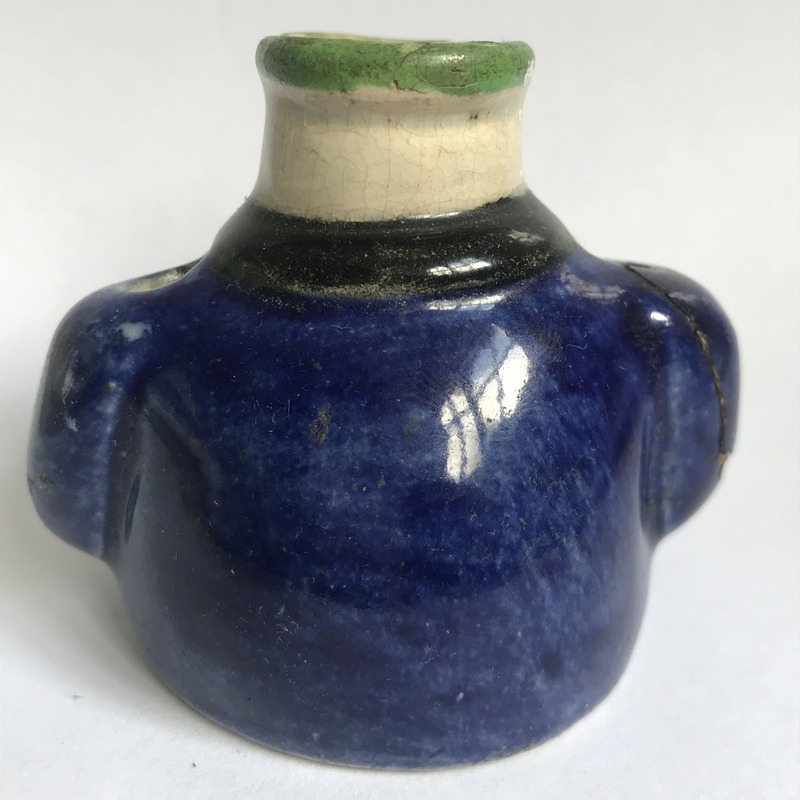 |
 |
 |
DANIEL LAMBERT INKWELL
This is a ceramic novelty inkwell from the early 19th century. It is in the likeness of Daniel Lambert (1770-1809), a gaol keeper and animal breeder from Leicester who became renowned during his lifetime as England’s heaviest man. At his death, aged 39, he weighed 52 stone and 11 lbs (335 kg).
He was said to have been extremely strong and athletically active, and claimed not to have drunk alcohol or eaten unusual amounts of food. Nevertheless, by 1806 he had become the heaviest authenticated person in recorded history and was effectively unemployable.
Although shy by nature and sensitive about his obesity, in desperation he saw the only way to avoid abject poverty was to exhibit himself as “a prodigy of nature,” and in the summer of 1806 he rented chambers in London where he charged visitors a shilling a view. Such was his popularity that he retired to Leicester a wealthy, if somewhat humiliated man.Daniel Lambert’s incredible size was commemorated throughout the 19th century and into the 20th. There were pubs and other businesses named after him. There were engravings and paintings, and he inspired memorabilia too, including another inkwell, a large brass one which (unfairly?) depicted him eating a whole roasted pig. There were also Staffordshire pottery figurines, money boxes and even a Daniel-shaped teapot.He remains a popular figure in Leicester, where he has been hailed as “one of the city’s most cherished icons,” and his enormous clothes and armchair are on permanent display in a museum. On the 200th anniversary of his death in 2009, Leicester staged a Daniel Lambert Day at the museum, which was attended by over 800 people.He is also lauded in Stamford, Lincolnshire, where he died unexpectedly while travelling home from London — present day Stamford Football Club is nicknamed ‘The Daniels’.
10th September 2021 Object 59
Buttons Nibs and Sugar
 |
 |
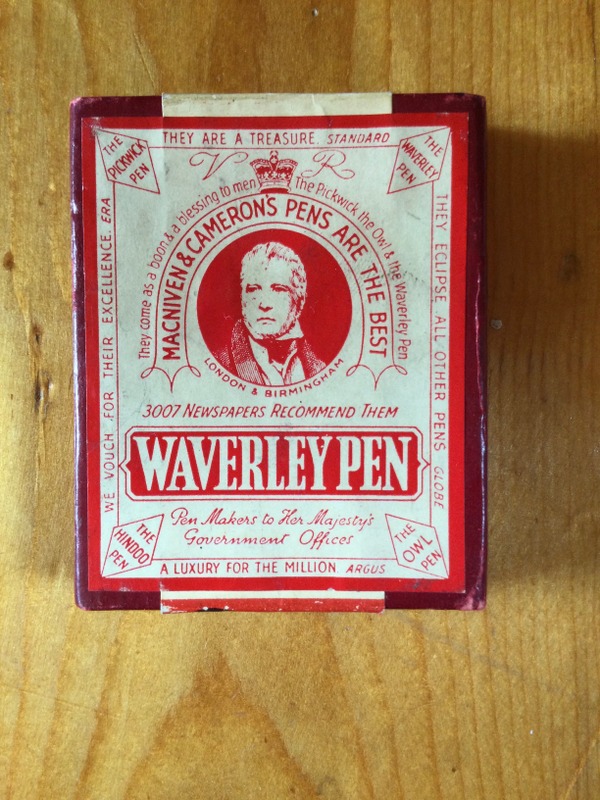 |
 |
 |
 |
This is the last of the 'Object of the Week series and marks what we hope will be the beginning of the end of the pandemic. So for this finale, here is a collection of objects from PW; some buttons, some pen nibs and some packets of sugar.
The sugar came from PW's school outing to the Tate and Lyle factory in the London docks, and they were given the boxes at the end of our tour. Probably around 1963? She remembers,
On arrival, the smell of candy floss from the refinery was wonderful. By the time we left, our noses had definitely had enough of it! But it was wonderful to see the mountains of sugar inside the factory and to learn that the “dirty” sugar got refined but then recoloured for Demerara!

